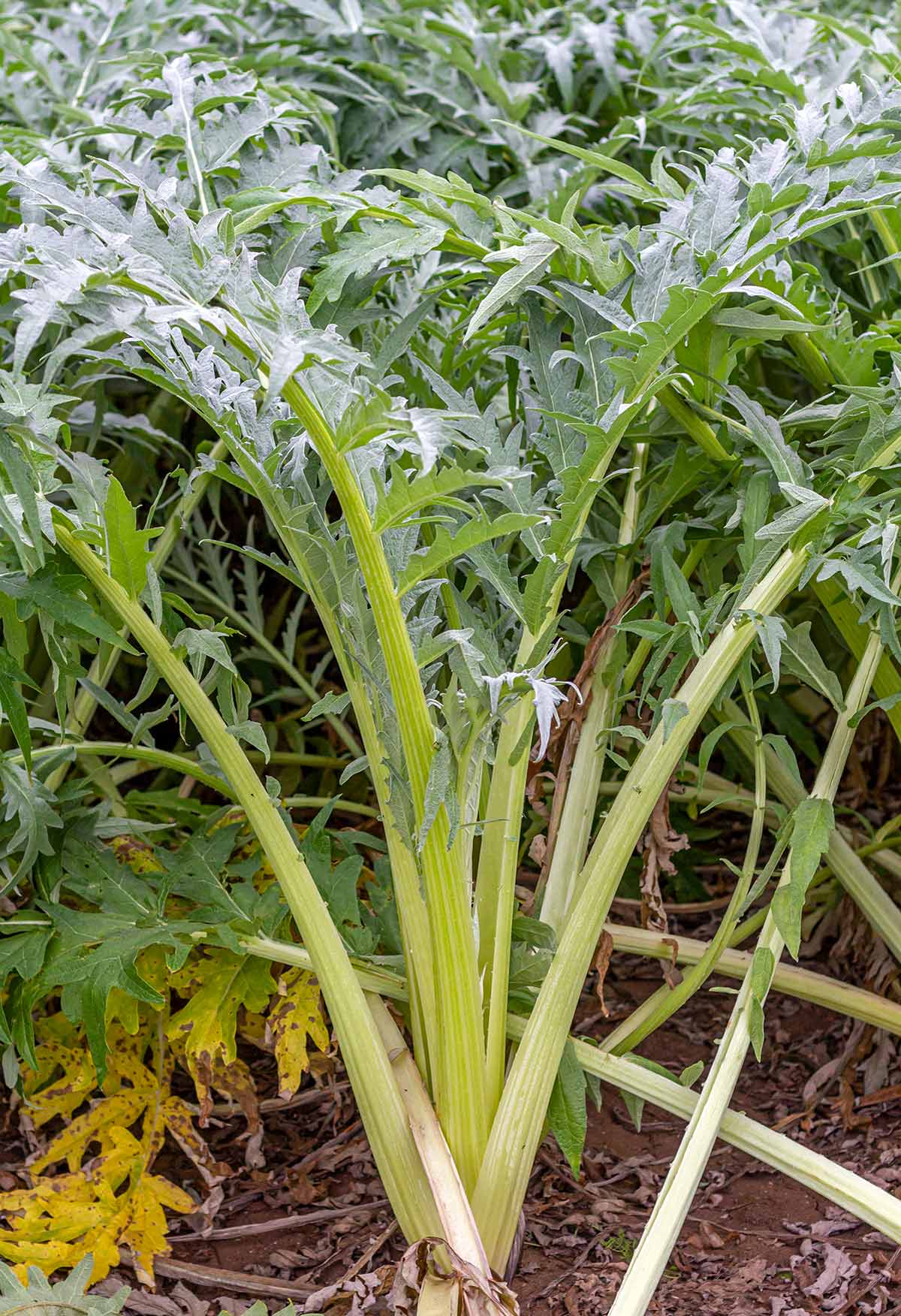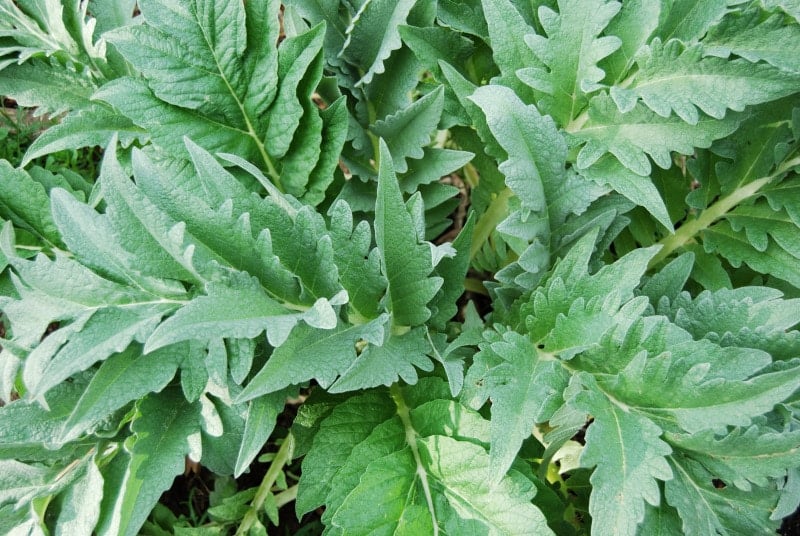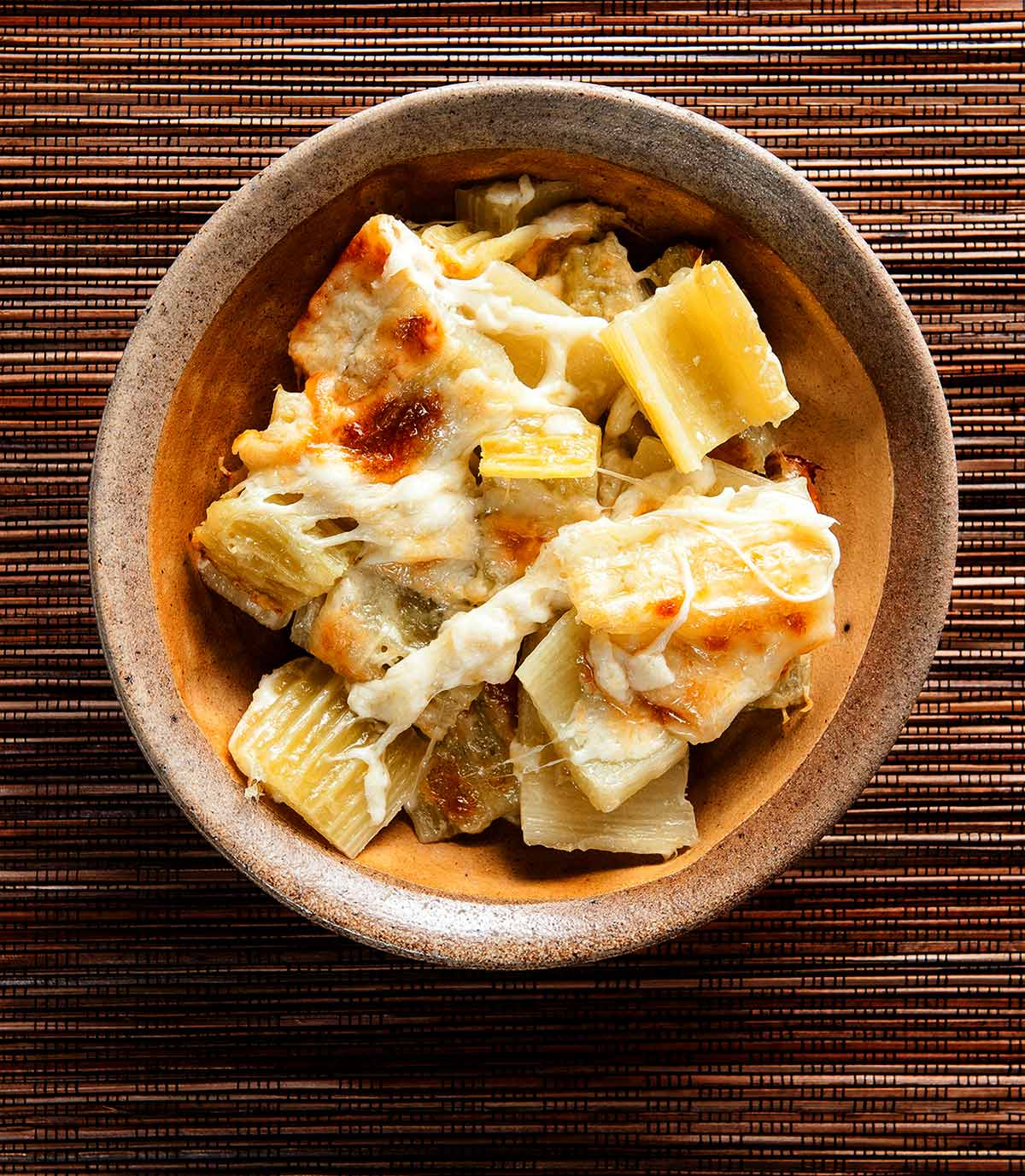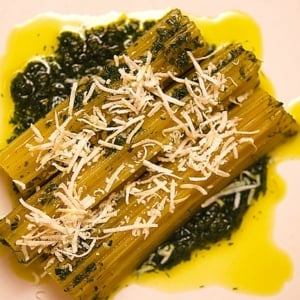As an Amazon Associate I earn from qualifying purchases.
Cardoons are slowly becoming more common in markets here in the United States, which is great. Because I’ve been growing cardoons in my yard for close to two decades. Here’s what I know about growing, prepping and cooking cardoons.

For those of you thinking, “What is a cardoon?” know that Cynara cardunculus is a relative of the artichoke; it’s a giant thistle.
At some point in the ancient world, gardeners gathered and domesticated the wild cardoons that grow all over the Mediterranean. Botanists believe those gardeners began their work on the artichoke, as the ancients really wanted larger, less thistly flower buds to eat with olive oil and garum. Understandable.
As for the cardoon, it is the stalk you eat. And wild cardoon stalks were only marginally tougher and spinier than the first domestic ones — or so the botanists reckon. Then around the Dark Ages someone decided they wanted to improve those stalks, which have the texture of celery but a flavor something like an echo of artichoke hearts.
So they bred the wild plant to be less spiny and to grow wider stalks. Thus the modern cardoon.

Growing Cardoons
It is a good thing that growing a cardoon plant is a low-maintenance endeavor. They easily grow from seed — I got my cardoon seed from Seeds from Italy — and they are perennial up to Zone 7, and really Zone 6 if you cut them to the ground and heap straw over the crowns in fall.
If you want to grow cardoon plants, know that you need 100 days from seed. If you don’t have that, you’re out of luck.
Here in Sacramento, Zone 9, they are, um, prolific. A weed, actually. You can see them wild all over the Sacramento-San Joaquin Delta, and mine regrow year after year after year. I literally have only planted them once, back in about 2005.
I cut them to the ground around Halloween, then they regrow like a phoenix. By late winter, they are lush, and the cool climate is perfect to harvest cardoons. Cardoon plants grow all summer, but once your temperatures hit about 70°F consistently, they get impossibly bitter. They will mellow out again once the weather cools in fall.
Harvesting Cardoons
Super easy. Use a big knife to slice them off at the ground, chop off the top leafy portion, then pull away the outer layers of leaf stalks, which will be punky, hollow and super bitter. What you want is the core.
It’s like celery, if you’ve ever grown that. The outer stalks are greener, more aromatic and more bitter than then hearts of celery. Cardoon plants are the same. Look for stalks that are tight, and that have a bloom on them, like the bloom on grapes or plums.
Another trick some people use is to wrap their cardoons for a couple weeks. They will wrap them in burlap or heavy paper or plastic, then twine. This hides the inner stalks from sunlight, so they whiten and are less bitter. I’ve done this, and it works, but no need in my yard. I have so many I can just use the natural inner stalks and compost the bitter outer ones.

Buying and Prepping
Most of you reading this will be buying cardoons in a store or farmer’s market. They are a winter vegetable, usually arriving around December and sticking around until early spring.
Cardoons can keep for weeks in the fridge. You want to buy them firm and pale. Mostly the top leaves will be chopped off already, otherwise your cardoon stalks will be four feet long. Keep them as they are until you want to cook your cardoons.
Now that you have some, what do you do with them?
They do require some work to prepare: You need to trim the spines with a vegetable peeler, peel the fibers off the outside of the ribs, and then boil them for 30 minutes in salty water with the juice of a lemon before doing anything else to them. So yeah, you need to be in the mood for cardoons.
Cardoons also discolor when cut, so you will want a bowl of cold water with lemon juice in it handy as you cut your stalks into pieces you want to eat. It’s the same with artichokes.

Pretty much every cardoon recipe requires this initial trimming and blanching step. Once that’s done, you have lots of options. Here’s what I call the Canon of Cardoons:
- Cardoons Gratin, in which they are baked with olive oil and cheese. Delicious and well worth making if you only plan to eat cardoons once in a great while; this recipe is Holly’s favorite.
- Cardoons in a bechamel sauce. Not being a fan of bechamel, I don’t make this preparation.
- Cardoon risotto. Silky, rich, and the slight bitterness of the cardoons really balances everything nicely.
- Blanched with the garlicky-anchovy sauce bagna cauda. Excellent as a canape.
- In a salad, tossed in a vinaigrette. Simple and good. Use only the innermost stalks, washed well and sliced thin.
- Fried. Another excellent if simple dish. An unusual appetizer, especially when you coat the cardoons in chickpea flour and fry with olive oil.

All of these dishes are excellent. But as my old co-worker would say in her best Parisian voice, “I am bored with your simple dishes.” Classics are classics for a reason, but there must be something more, yes?
As for me, I decided to use the bible: I wrote recently about an unusual book called The Flavor Bible, which offers long lists of flavors and ingredients that have been proven to go well together; I have begun developing recipes using these lists. Now cardoons are esoteric enough to not appear in that book, but artichokes are. So I improvised.
What I came up with was honeyed cardoons with pine nuts and thyme.
Damn good. Real damn good. Can’t-stop-eating-it good. Sweet, savory, meaty from the pine nuts, slightly crunchy with just a hint of saline bitterness from the cardoons and the dry Spanish sherry I used.
Another great way to eat cardoons is to brine pickle them: Submerge the inner stalks in a brine of 1/4 cup kosher salt to 1 quart of water for a week or three, and they will be lacto-fermented cardoons. Probably my favorite way to eat cardoons other than the gratin.
All of this is to say that cardoons are worth it. They do take some time to pre-prepare, but many things in life are worth a little work and some patience. There is really nothing quite like the flavor of this odd vegetable, and it happens to be very high (for a plant) in calcium, potassium, iron — and, as befitting the stalk of a thistle — fiber.
Honeyed Cardoons with Pine Nuts and Thyme
Ingredients
- 1 medium onion
- 1/2 pound cardoons
- 2 tablespoons olive oil
- 1/4 cup dry sherry, or white wine
- 2 tablespoons honey
- 1 tablespoon fresh thyme
- 1/4 cup toasted pine nuts
- Salt and black pepper
Instructions
- Trim the cardoons and boil them for 30 to 40 minutes in salty water with the juice of 2 lemons thrown in. This can be done up to a day ahead.
- Slice the cardoons into 1/2 inch pieces. Slice the onion into half-moons. Toast the pine nuts — watch them, as pine nuts go from toasted to burnt in a heartbeat.
- Heat the olive oil in a large sauté pan over medium-high heat. Sauté the onions with some salt until just beginning to brown on the edges. Add some salt. Add in the cardoons and stir to combine. Let this cook for a minute or two.
- Add the dry sherry. If you don’t have dry sherry, use a dry white wine. Turn the heat up to high and boil it furiously. Add the honey and stir to combine. Add the pine nuts. Let this boil down to a glaze. Turn off the heat and toss in the thyme and add some fresh ground black pepper. Toss well to combine and serve at once.
Nutrition
Nutrition information is automatically calculated, so should only be used as an approximation.






In tunisia they make a great couscous with Cardoon as the main vegetable in the dish. We just had this for dinner with my first crop of Cardoon.
Sharon: Nice! What’s the general recipe?
We live in South West England and I have about three Cardoon plants on my allotment. They are now (mid June ) about 7 feet high and each one has about 4 or 5 small ‘buds’ just opening. I have heard that you can eat these in a similar way to Artichokes…has anybody got a tried and tested recipe? This will be our first year to try and eat the stalks too.
I came across this lovely article just in time. Being a newbie to cardoons, I only just recently learned that I need to harvest the stalks instead of waiting for it to flower like an artichoke! The gratin has my name on it, as does the bagna cauda. I will also give your honey/thyme/pine nut recipe, because let’s just say I’ve got an awful lot of cardoon to work with.
I just bought a cardoon plant about 8 inches tall. Thanks for the info and I will give it a try. Up here in the San Juan Islands so I hope the weather is warm enough!
to grow the cardoons in winter, that to become bitter-sweet(blanch them) you need to cover the plant rolled with some straw and newspapers. When they are hit by the first or second frost, they get ready to be cut and prepared to be eaten. My dad used to cultivate a lot of them and he was protecting them in this way. They are a good substitute for eggplants for a “Parmigiana” or steamed and sauteed with bacon or pancetta. I have just seen a “Ghiotta”(gluttony) recipe that involves a preparation similar to parmigiana but with a layer done with “milanese” style veal…. probably I will try it….
I took over a garden plot in our local community garden and the previous gardener had planted one. This year was the first year it bloomed,no one knew what it was till it produced the artichoke looking flowers. I finally discovered what it was when I was looking in a Sow True Seed seed catalog and spotted it. Know that I know what it is and how to use it,Im going to see if it will sell at our local farmers market here in Jonesborough, TN .
Very nice article! I’d like to speak up for the cardoon buds, however. I steam them, cut them in half and eat the small hearts. They remind me of the artichoke heart omelet I had in Florence and, in my opinion, have more flavor than regular artichoke hearts.
I’d never heard of cardoons until I saw the seeds at Baker Creek. Since artichokes are my favorite all time veggie I’m gonna have to try ’em. Thanks to Pantasilla for the tip on eating the thistle heads!
I have had cardoons as structural plants in the border for years and ate the thistle heads – before they opened – as they are just like artichokes and as delicious because I didn’t want them to see all over the bed. This year I moved some to another part of the garden and now, in November, they are about four feet high and I thought I’d try the stalks. Great to have all these recipes so now I’d better go and start preparing them. I think, to start, I’ll do the cheese one. But I can really recommend the artichoke part. Not as large a heart as normal artichokes but fun as a starter with good conversation,as you pull off and suck the petals with melted butter, pepper and lemon juice….
Very interesting. I’ll have to try it next year. I just attempted growing and cooking cardoon and thought it was challenging. https://www.mysuburbanhomestead.com/harvesting-cooking-cardoon/
Hi, here is how Persians cook cardoon. This is a recipe from a cook book called “New food of Life” by Najmieh Batmangelij.
Cardoon Khoresh
Makes 6 servings
Preparation time: 35 minutes
Cooking time: 2 hours
Khoresh-e kangar
1 pound fresh cardoon stalks
1 teaspoon vinegar
2 large onions, peeled and thinly
sliced
1 pound stew meat, (lamb, veal, or
beef), cut into 1-inch cubes, or 2
pounds veal shank, or 2 pounds
chicken legs, cut up
1/3 cup oil
1 teaspoon salt
1/4 teaspoon freshly ground
black pepper
1/4 teaspoon turmeric
3 cups chopped fresh parsley
1/2 cup chopped fresh mint
4 tablespoons fresh lime juice or 1/2
cup sour grape juice (ab ghureh)
1/4 teaspoon ground saffron, dissolved
in 1 tablespoon hot water
1. Carefully remove and discard prickly parts of cardoon stalks after removing
leafy heads. Be sure to remove strings by lifting them with the tip of a knife and
peeling them off. Cut into pieces 2 inches long. To prevent them from discoloring
and to keep them tender, soak peeled cardoon pieces in a bowl of water with a
splash of vinegar until ready to use.
2. In a Dutch oven, brown onions and meat or chicken in 3 tablespoons oil. Add
salt, pepper, and turmeric. Pour in water-2 cups for meat, 11/2 cups for chicken.
Cover and simmer over low heat for about 55 minutes for meat or 30 minutes for
chicken, stirring occasionally.
3. Drain the cardoon. In a skillet, saute the cardoon pieces in the remaining oil. Add parsley and mint and fry for 10 minutes longer.
4. When the meat is done, add lime juice, saffron water, and the cardoon. Cover
and simmer for 1 hour over low heat.
5. Check to see if the cardoons are tender. Taste the khoresh and
adjust seasoning.
6. Serve hot with chelow, saffron-steamed rice.
I make a different version of this dish by replacing the parsley and mint with sun-dried tomatoes; keeping everything else the same. Both recipes are delicious!
I’m thinking of this dish for Christmas! Wanted to tell you that most pine nuts are from China these days and are flavorless (not to mention, they are from China . . . .) I found those hard to find Italian pine nuts on nutsonline.com – they are wonderful. My holiday dinner this year: roasted goose, ravioli w/marinara, your cardoon recipe. Can’t wait! Thank you!
Thanks for the speedy response. I’m zone 6b and don’t have the luxury of cutting my cardoons back. Last year I was so enamored with them I never got around to eating them before a freeze came and knocked ’em down. They didn’t come back either. So I planted 6 new plants and they are just as lovely. But I was not aware one should not eat them in the summer.
I have a long line of Italian friends who are drooling over the prospect of cardoni and I thought I would get a jump on things and start trying out recipes now. I plan(ned) on having them all over for a cardoni buffet — if I can convince my poor husband to ever eat it again.
Should I plan on wrapping my plants in the early fall to blanch them ?
Hmmmm…. I’ m thinking about cardoons with chestnuts… wonder how that might taste?
Brenda: Dunno exactly what happened, although the first thing that springs to mind is that you are eating cardoons in the summer, when they are at their toughest and most bitter.
In California, I cut my cardoons down after they flower in summer and then water the hell out of them so they come up again by Thanksgiving. I eat them in winter, then cut them again, and I get a second crop in March-April. Unless you are in a very cool area, summer cardoons would indeed be really bitter. Where are you located?
I need a little Cardoon help… I cut about a dozen leaves last week and carefully trimmed them, pulled the strings, soaked them in acidulated water, and boiled them for 30 minuted in salted water. I made the honeyed cardoons with pine nuts and thyme — and it was awful! Tough, bitter and… uhm… gave my husband some intestinal distress.
The plants are young and the leaves I picked were about 1 to 2 feet long. Did I pick them too early without blanching the plants? Should I not have picked leaves and instead harvested the entire plant and only used interior leaves?
Help! I’m crushed by a cardoon.
I’ve only been growing my cardoon for 3 years after getting a cutting from a friend ,this year it has grown to over 6′ in height and has 9 thisle heads its amazing and is a great conversational piece when anyone comes to visit I have never tried to eat it but this year I may try
Loch sloy! from a fellow Scot. Thanks for teaching me about cardoons. I have been curious about them and this is a great primer.
It was fun to see the story about “our Hank” in the Bee.
I do blanch my cardoons in the garden for about 30 days. So I don’t have to boil them for 30 minutes..Just peeled, trimmed and straight into heavy cream. Cover with bread crumbs. Bake. (see… no bechamel!)
I have learn to harvest them before frost (and they truly don’t like frost), so September & October are cardoon eating months in the Northern Piedmont. For the few of us who grow them.
This year, I will see if I can overwinter them in the polytunnel. They did not survive last winter (admittedly very cold)
Thanks for the other suggestions. Will resurrect them in September…
Ours are about 1 inch high – maybe we’ll actually eat them this year instead of just watching them grow with awe.
PS Easily grown from seed.
hello! where did you get your plants? how many for 2 people? i love cardoon. italian family…what can i say?